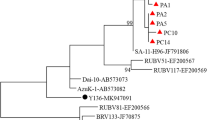Summary
The origin of, and relationship between human and bovine serotype G 8 rotaviruses were investigated by genomic hybridisation. Radiolabelled mRNAs of human G 8 rotaviruses 69 M (isolated in Indonesia) and HAL 1271 (isolated in Finland), and bovine rotaviruses KK 3 (G 10) and NCDV (G 6), were used as probes. The products of liquid hybridisation between the probes and the genomic RNA of human and bovine rotaviruses, including bovine G 8 rotavirus 678 (isolated in Scotland) and two other Finnish human G 8 rotaviruses HAL 1166 and HAL 8590, were examined by separation in polyacrylamide gels. The genomes of Finnish human G 8 rotaviruses were similar to those of bovine G 6 and G 10 rotaviruses. Neither Indonesian human G 8 nor bovine G 8 viruses had high levels of similarity to each other or to other bovine and human rotaviruses. Thus these three epidemiologically distinct G 8 rotaviruses have different origins and may be derived by reassortment with rotaviruses of a third, as yet unknown, host species. The similarity between the Finnish isolates and the bovine isolate NCDV suggests that they have diverged recently and that these human G 8 rotaviruses may be derived from a zoonotic infection, or alternatively, from the live rotavirus vaccine of bovine origin which has been used to vaccinate Finnish children.
Similar content being viewed by others
References
Albert MJ, Unicomb LE, Bishop RF (1987) Cultivation and characterization of human rotaviruses with “super-short” RNA patterns. J Clin Microbiol 25: 183–185
Bohl EH, Theil KW, Saif LJ (1984) Isolation and serotyping of porcine rotaviruses and antigenic comparison with other rotaviruses. J Clin Microbiol 19: 105–111
Browning GF, Chalmers RM, Fitzgerald TA, Corley KTT, Campbell I, Snodgrass DR (1992) Rotavirus serotype G 3 predominates in horses. J Clin Microbiol 30: 59–62
Gerna G, Sarasini A, Zentilin L, Di Matteo A, Miranda P, Parea M, Battaglia M, Milanesi G (1990) Isolation in Europe of 69 M-like (serotype 8) human rotavirus strains with either subgroup I or II specificity and a long RNA electropherotype. Arch Virol 112: 27–40
Gouvea V, Ho M-S, Glass R, Woods P, Forrester B, Robinson C, Ashley R, Riepenhoff-Talty M, Clark HF, Taniguchi K, Meddix E, McKellar B, Pickering L (1990) Serotypes and electropherotypes of human rotavirus in the USA: 1987–1989. J Infect Dis 162: 362–367
Kutsuzawa T, Konno T, Suzuki H, Kapikian AZ, Ebina T, Ishida N (1982) Isolation of human rotavirus subgroups 1 and 2 in cell culture. J Clin Microbiol 16: 727–730
Malherbe HH, Strickland-Cholmley M (1967) Simian virus SA 11 and the related “O” agent. Arch Ges Virusforsch 22: 235–245
Mattion NM, Bellinzoni RC, Blackhall JO, LaTorre JL, Scodeller EA (1989) Antigenic characterization of swine rotaviruses in Argentinia. J Clin Microbiol 27: 795–798
Matsuda Y, Nakagomi O (1989) Antigenic and molecular charcterization of bovine rotaviruses isolated in Japan. Res Virol 140: 337–350
Matsuno S, Hasegawa A, Mukoyama A, Inouye S (1985) A candidate for a new serotype of human rotavirus. J Virol 54: 623–624
Mebus C, Kono M, Underdahl NR, Twiehaus MJ (1971) Cell culture propagation of neonatal calf diarrhoea (scours) virus. Can Vet J 12: 69–72
Murakami T, Hirano N, Chitose K, Tsuchiya K, Ono K, Sato F (1987) A survey on bovine rotavirus type-1-associated neonatal calf diarrhoea in a beef herd. Jpn J Vet Sci 49: 23–30
Murakami Y, Nishioka N, Hashiguchi Y, Kuniyasu C (1983) Serotypes of bovine rotaviruses distinguished by serum neutralisation. Infect Immun 40: 851–855
Nakagomi O, Nakagomi T, Akatani K, Ikegami N (1989) Identification of rotavirus genogroups by RNA-RNA hybridisation. Mol Cell Probes 3: 251–261
Nakagomi O, Nakagomi T, Hoshino Y, Flores J, Kapikian AZ (1987) Genetic analysis of a human rotavirus that belongs to subgroup I but has an RNA pattern typical of subgroup II human rotaviruses. J Clin Microbiol 25: 1159–1164
Nakagomi O, Ohshima A, Aboudy Y, Shif I, Mochizuki M, Nakagomi T, Gotlieb-Stematsky T (1990) Molecular identification by RNA-RNA hybridization of a human rotavirus that is closely related to rotaviruses of feline and canine origin. J Clin Microbiol 28: 1198–1203
Ohshima A, Takagi T, Nakagomi T, Matusno S, Nakagomi O (1990) Molecular characterization by RNA-RNA hybridisation of a serotype 8 human rotavirus with “super-short” RNA electropherotype. J Med Virol 30: 107–112
Qian Y, Green KY (1991) Human rotavirus strain 69 M has a unique VP 4 as determined by amino acid sequence analysis. Virology 182: 407–412
Snodgrass DR, Fitzgerald T, Campbell I, Scott FMM, Browning GF, Miller DL, Herring AJ, Greenberg HB (1990) Rotavirus serotypes 6 and 10 predominate in cattle. J Clin Microbiol 28: 504–507
Vesikari T, Isolauri E, Delem A, d'Hondt E, Andre FE, Beards GM, Flewett TH (1985) Clinical efficacy of the RIT 4237 live attenuated bovine rotavirus vaccine in infants vaccinated before a rotavirus epidemic. J Pediatr 107: 189–194
Wyatt RG, James HD Jr, Pittman AL, Hoshino Y, Greenberg HB, Kalica AR, Flores J, Kapikian AZ (1983) Direct isolation in cell culture of human rotaviruses and their characterization into four serotypes. J Clin Microbiol 18: 310–317
Author information
Authors and Affiliations
Rights and permissions
About this article
Cite this article
Browning, G.F., Snodgrass, D.R., Nakagomi, O. et al. Human and bovine serotype G 8 rotaviruses may be derived by reassortment. Archives of Virology 125, 121–128 (1992). https://doi.org/10.1007/BF01309632
Received:
Accepted:
Issue Date:
DOI: https://doi.org/10.1007/BF01309632




